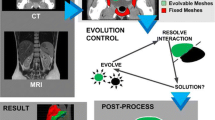Abstract
In this paper, we present a novel adaptive B-Snake model for object contour extraction. A cubic B-Snake model is developed for extracting 2D deformable objects from medical images, with an adaptive control point insertion algorithm that is suggested to increase the flexibility of B-Snake to describe complex shape. This method overcomes the problems that exist in other B-spline based model that have to decide beforehand or exhaustively search over a range of value for the number of control points. Hence, these methods are less flexible to describe unknown complex shapes. A minimum energy method which we called Minimum Mean Square Error (MMSE) is proposed for B-Snake to push it to the target boundary. The internal forces are not required in deforming B-Snake since the representation of B-Spline has guaranteed smoothness by hard implicit constraints. The proposed B-Snake model has been tested on object contour extraction such as human brain ventricle in Magnetic Resonance (MR) images. The experimental results demonstrate the capability of adaptive shape description and object contour extraction.
Similar content being viewed by others
References
W.S.I. Ali and F.S. Cohen, “Registering coronal histological 2-D sections of a rat brain with coronal sections of a 3-D brain atlas using geometric curve invariants and B-Spline representation,” IEEE Transactions on Medical Imaging, Vol. 17, No. 6, 1998.
A.M. Baumberg and D.C. Hogg, “Learning flexible models from image sequences,” in European Conference on Computer Vision’94, 1994, Vol. 1, pp. 299–308.
M.A.T. Figueiredo, J.M.N. Leitão, and A.K. Jain, “Unsupervised contour representation and estimation using B-Splines and a minimum description length criterion,” IEEE Transactions on Image Processing, Vol. 9, No. 6, pp. 1075–1087, 2000.
J. Flusser and T. Suk, “Pattern recognition by A affine moment invariant,” Pattern Recognition, Vol. 26, pp. 167–174, 1993.
A.L.N. Fred, J.S. Marques, and P.M. Jorge, “Hidden Markov models vs syntactic modeling in object recognition,”Proceedings of International on Image Processing (ICIP’97), 1997, pp. 893–896.
Y. Gu and T. Tjahjadi, “Coarse-to-fine planar object identification using invariant curve features and B-Spline modeling,” Pattern Recognition, Vol. 33, pp. 1411–1422, 2000.
Z. Huang and F.S. Cohen, “Affine-Invariant B-Spline moments for curve matching,” IEEE Transactions on Pattern Analysis and Machine Intelligence, Vol. 5, No. 10, Oct. 1996.
M. Kass, A. Witkin, and D. Terzopoulos, “Snakes: Active contour models,” Int. J. Computer Vision, Vol. 1, No. 4, pp. 321–331, 1987.
A.K. Klein, F. Lee, and A.A. Amini, “Quantitative coronary angiography with deformable spline models,” IEEE Transactions on Medical Imaging, Vol. 16, No. 5, 1997.
M.J. Paulik, M. Das, and N.K. Loh, “Nonstationary autoregressive modeling of object contours,” IEEE Transactions on Signal Process, Vol. 40, pp. 660–675, 1992.
E. Person and K.S. Fu, “Shape discrimination using fourier descriptors,” IEEE Transactions on Systems Man Cybernet, Vol. 7, pp. 170–179, 1977.
T. Stammberger, S. Rudert, M. Michaelis, M. Reiser, and K. H. Englmeier, “Segmentation of MR images with B-Spline snakes: A multi-resolution approach using the distance transformation for model forces,” CEUR Workshop Proceedings, Vol. 12, 1998.
Q.M Tueng and W.W. Boles, “Wavelet-based affine invariant representation: A tool for recognizing planar objects in 3D space,” IEEE Transactions on PAMI, Vol. 19, pp. 846–857, 1997.
Y. Wang, E.K. Teoh, and D. Shen, “Lane detection using B-Snake,” IEEE International Conference on Information, Intelligence and Systems (ICIIS’99), Washington, DC, Nov. 1–3, 1999.
Y. Wang, D. Shen, and E.K. Teoh, “A novel lane model for lane boundary detection,” IAPR Workshop on Machine Vision Applications, 1998, pp. 27–30.
Y. Wang, E.K. Teoh, and D. Shen, “Lane detection and tracking using B-Snake”, Image and Vision Computing, Vol. 22, No. 4, 2004, pp. 269–280.
Y. Wang, E.K. Teoh and D. Shen, “Structure-Adaptive B-Snake for Segmenting Complex Objects,” International Conference on Image Processing (ICIP 2001), Thessaloniki, Greece, Oct 7–10, 2001, pp. 769–772.
Y. Wang, Object segmentation and matching using B-Spline model, PhD thesis Nanyang Technological University, Singapore, May 2004.
C. Xu and J.L. Prince, “Snakes, shapes, and gradient vector Flow,” IEEE Transactions on Image Processing, pp. 359–369, March 1998.
Author information
Authors and Affiliations
Corresponding author
Rights and permissions
About this article
Cite this article
Wang, Y., Teoh, E. Object Contour Extraction Using Adaptive B-Snake Model. J Math Imaging Vis 24, 295–306 (2006). https://doi.org/10.1007/s10851-005-3629-8
Published:
Issue Date:
DOI: https://doi.org/10.1007/s10851-005-3629-8




